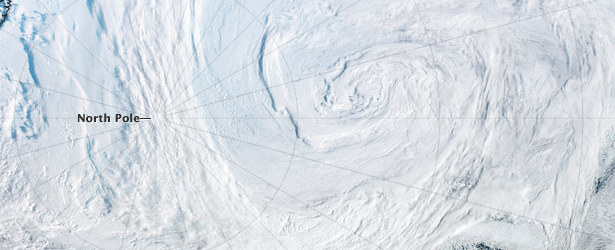Increase in Arctic cyclones linked to climate change, new study shows

Winter in the Arctic is not only cold and dark, it is also storm season when hurricane-like cyclones traverse the northern waters from Iceland to Alaska. These cyclones are characterized by strong localized drops in sea level pressure, and as Arctic-wide decreases in sea level pressure are one of the expected results of climate change, this could increase extreme Arctic cyclone activity, including powerful storms in the spring and fall.
A new study in Geophysical Research Letters uses historical climate model simulations to demonstrate that there has been an Arctic-wide decrease in sea level pressure since the 1800's.
“This research shows that the Arctic appears to be expressing symptoms expected from ongoing climate change,” said Dr. Stephen Vavrus from the University of Wisconsin-Madison. “The long-term decline in atmospheric pressure over most of the Arctic is consistent with the response typically simulated by climate models to greenhouse warming, and this study finds a general corresponding increase in the frequency of extreme Arctic cyclones since the middle 19th century.”
Tracking changes in Arctic cyclone activity through time, Vavrus calculated a statistically significant, though minor, increase in extreme Arctic cyclone frequency over the study period, with increases strongest near the Aleutian Islands and Iceland. Dr. Vavrus suggests that, as of yet, the effect of climate change on Arctic cyclone activity has been minimal, but that future changes in polar climate will drive stronger shifts.
“One societally relevant implication is that more storminess probably means more erosion of Arctic coastlines, especially in tandem with declines in buffering sea ice cover and increases in thawing coastal permafrost,” concluded Dr. Varnus. “Erosion of Arctic coastlines has already been growing more severe during recent decades, and this study points to a contributing factor that will likely become an even more recognizable culprit in the future.”
Reference:
- Vavrus, S. J. (2013), Extreme Arctic cyclones in CMIP5 historical simulations, Geophys. Res. Lett.,40, 6208–6212, doi:10.1002/2013GL058161.
Source: Wiley
Featured image: NASA / Earth Observatory (Aqua / MODIS)

My question is this: has anyone done any historic research to see if the increase in cyclonic activity is cyclical? In other words is there a time in past history that saw an increase in this activity and now we are witnessing the cycle come around again where this activity would increase. I know the easy answer for people is climate change but it might be helpful to see if there is anything in the past